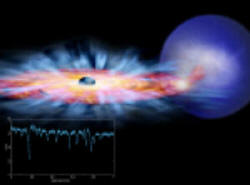 |
 |
 |
 |
 |
||
| Science of Light -> X Rays |
|
X-ray radiation contains the second highest amount of energy in the electromagnetic (EM) spectrum. Its wavelengths, ranging between 10 nanometers (10 x 10-9 meters) and 10 picometers (10 x 10-12 meters), are much shorter than visible light. X-rays lie between ultraviolet "light" and gamma rays on the electromagnetic spectrum. Gamma rays are produced by nuclear transitions, while X-rays are the result of accelerating electrons. X-rays are produced by matter which is heated to millions of degrees and are often caused by cosmic explosions, high speed collisions, or by material moving at extremely high speeds. This radiation has such high energy that specially made, angled mirrors must be used to help collect this type of light. High-energy observations also allow us to study the hottest regions of the Sun's atmosphere.
Astronomical sources of X-rays This "true color" Chandra image of N132D shows the beautiful, complex remnant of an explosion of a massive star in the Large Magellanic Cloud, a nearby galaxy about 180,000 light years from Earth. The colors represent different ranges of X-rays, with red, green, and blue representing, low, medium, and higher X-ray energies respectively. X-ray astronomy has led to the discovery of black holes in space.
Black holes give off radiation because matter falling into them loses gravitational energy which may result in the emission of radiation before the matter falls into the event horizon. The infalling matter has angular momentum, which means that the material cannot fall in directly, but spins around the black hole. In some neutron star or white dwarf systems, the magnetic field of the star is strong enough to prevent the formation of an accretion disc. The material in the disc gets very hot because of friction, and emits X-rays. The material in the disc slowly loses its angular momentum and falls into the compact star. In neutron stars and white dwarfs, additional X-rays are generated when the material hits their surfaces. X-ray emission from black holes is variable, varying in luminosity in very short timescales. The variation in luminosity can provide information about the size of the black hole. Other Uses of X-Rays Artificially produced X-rays have long been used to "see" through skin and muscle tissue to make medical "X-ray images" of bones when checking for fractures.
|
|



 This material often forms an accretion disk. Similar luminous accretion disks can also form around white dwarfs and neutron stars, but in these the infalling gas releases additional energy as it slams against the high-density surface with high speed. In case of a neutron star, the infall speed can be a sizeable fraction of the speed of light. The picture to the right is also from Chandra.
This material often forms an accretion disk. Similar luminous accretion disks can also form around white dwarfs and neutron stars, but in these the infalling gas releases additional energy as it slams against the high-density surface with high speed. In case of a neutron star, the infall speed can be a sizeable fraction of the speed of light. The picture to the right is also from Chandra.